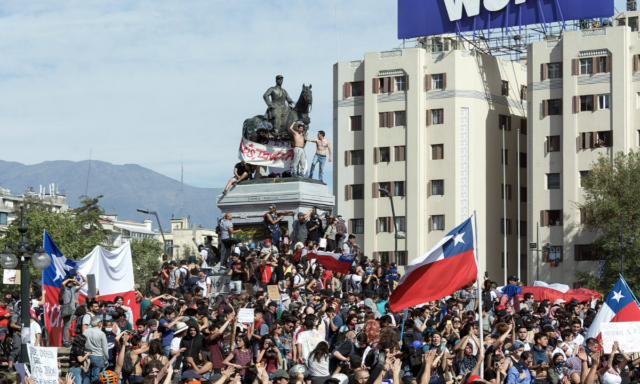For residents of Santiago de Chile, October 2019 began with the news that subway fares would increase by around 4%. Despite being small, the rise triggered a furious reactionperhaps instigated by the then Minister of Economy, Juan Andrés Fontaine, who recommended that the population wake up earlier, as the Santiago metro was cheaper before 7am.
The news of the increase and Fontaine’s statement, considered by many a way of mocking the working class, are two determining elements to understand what erupted in Chile on October 18, 2019, considered the most serious crisis since the country returned to democracy in 1990.
High school and university students took to the streets to protest against the increase in subway fares, and other citizens joined the demonstration of discontent. There were clashes with the police, outbreaks of disturbances and looting.
It was the beginning of the so-called “pop social” (social explosion) – series of demonstrations and disturbances that began in Santiago and spread across the country, with greater intensity between October 2019 and March 2020.
Photo: Martin Bernetti/AFP
“It was a movement that brought together several complaints against the rulers of the time, with regard to the economy and a democratic culture in which people were not only not heard, but also had their daily lives violated”, says Jorge Saavedra, professor at Faculty of Communication and Letters at Diego Portales University, in Santiago, and a doctorate in communication from the University of London.
“It is important to remember that one of the key concepts of the mobilization was dignity. People were tired of feeling violated”, he points out.
‘It was enough to have pain and a villain’
For Cristóbal Bellolio, political scientist and professor at the Adolfo Ibáñez University, in the Chilean capital, the pop it was a “populist moment”.
“There was a plebeian protest against the institutions commanded by the world of political parties and businesspeople – elites guilty, in some way, of hijacking the progress of Chileans,” he says. “THE pop It also has to do with the constitution of a people based on the alliance of different groups that have been oppressed or marginalized.”
Bellolio refers to the wide range of demands that found space in the demonstrations. The protests brought together opponents of highway tolls, defenders of the demands of the Mapuche indigenous people, people who called for the resignation of the then president Sebastian Piñeragroups demanding housing, among others.
“It was enough to have a pain and a villain to participate in this moment of reparation”, comments the specialist, who defines the pop as a conjunction of “demands for democratic equality”.
“The construction and violation of dignity is not just about a salary. They have to do with a daily existence and a relationship with power in which people perceive that they are being abandoned – something they can tolerate –, but abuse is a sensitive issue”, analyzes Saavedra.
Photo: Martin Bernetti/AFP
“The Chilean model left people to their own devices, but at the same time, the discourse of personal effort prevailed. Thus, people feel a certain pride in working from sunrise to sunset and paying for everything. But what sparked anger was the perception that they were being abused by excessive fees for basic services, by extortionate student loans, by ministers who mocked poverty,” he says.
Demobilized youth
Five years later, where are the young people who were the driving force behind the 2019 mobilization? “Today I don’t see a mobilization of young people in any aspect, except those linked to watching shows or gender issues. The causes that used to mobilize students today no longer mobilize them”, says Saavedra.
The professor believes that the new university generations, perhaps because they have free education (for the most part), transport whose prices have mostly remained frozen, in addition to a food system, are quite comfortable with the current situation.
“I think the frustration today has to do with the fact that they asked Chile to take a step back, to endure violent and turbulent times, in the hope that it would then move forward two steps. The problem is that the pandemic came, and we didn’t move forward. There is accumulated hopelessness, because for everyone pop it meant sacrificing something for a future that, in the end, didn’t come”, points out Bellolio, mentioning the failed experience of the two constituent processes with which attempts were made to contain the unrest.
The political scientist, however, believes that the constitutional solution was the right reading for the political moment in which the Chile was passing, “because it catalyzed the destructive energy into constructive energy.”
In December 2023, Chileans rejected, in a referendum, the second proposal for a new Constitution and decided to maintain the current one, inherited from the dictatorship of Augusto Pinochet (1973-1990). In September 2022, the first proposal, written by a left-wing majority convention that proposed a radical transformation of Chilean institutions, had suffered a resounding rejection.
‘Substantially nothing has changed’
Today, the epicenter of the 2019 demonstrations is taking on a new face. Plaza Italia, in Santiago, enthusiastically called “Plaza Dignidad” at the time of the protests, has grass and flowers again. Surrounding stores are slowly resuming their activities, and authorities are trying to erase the traces of October 2019.
“We are at a stage where it is possible to look at what happened with perspective and we can say that, substantially, nothing has changed. But we know that the promise that ‘everything will change’ embraced by pro-mobilization sectors is not possible, just as the promise from the right that ‘we will be very prone to change’ is not credible”, says Saavedra.
For the professor, if the country does not advance on fundamental issues, including some of the demands of pop five years ago, it cannot be ruled out that “anger will return to the streets”.






